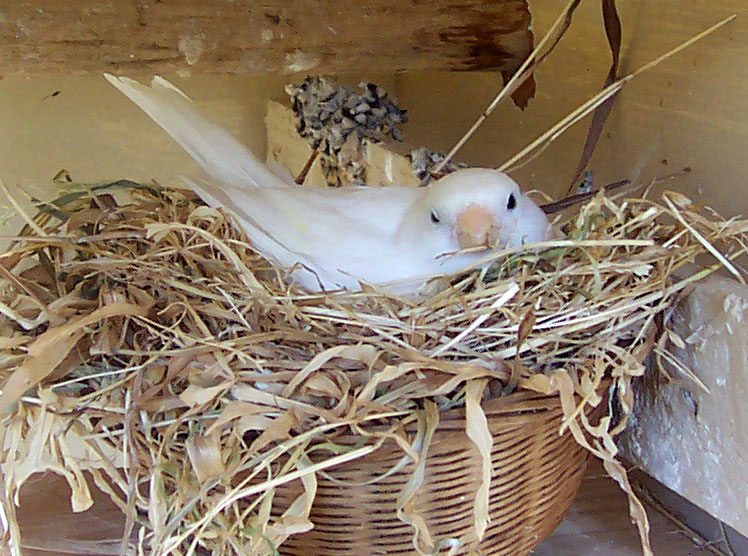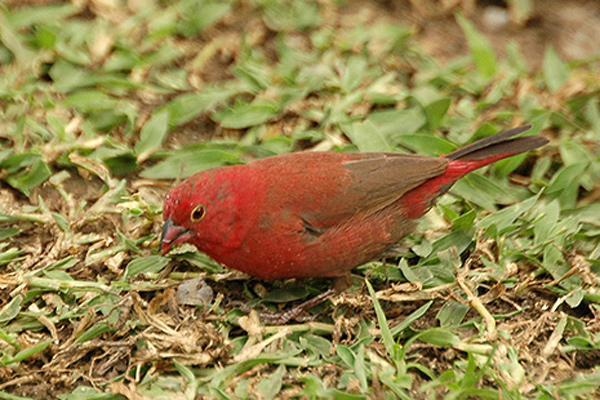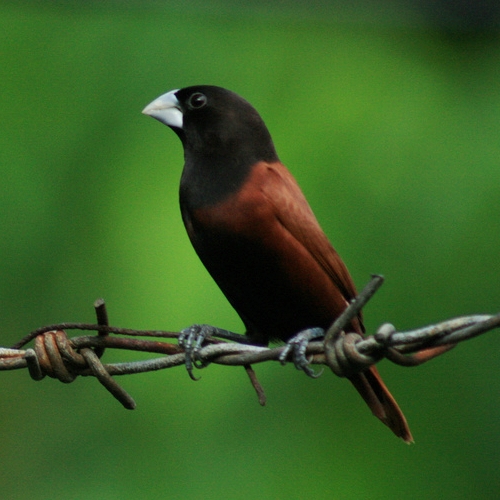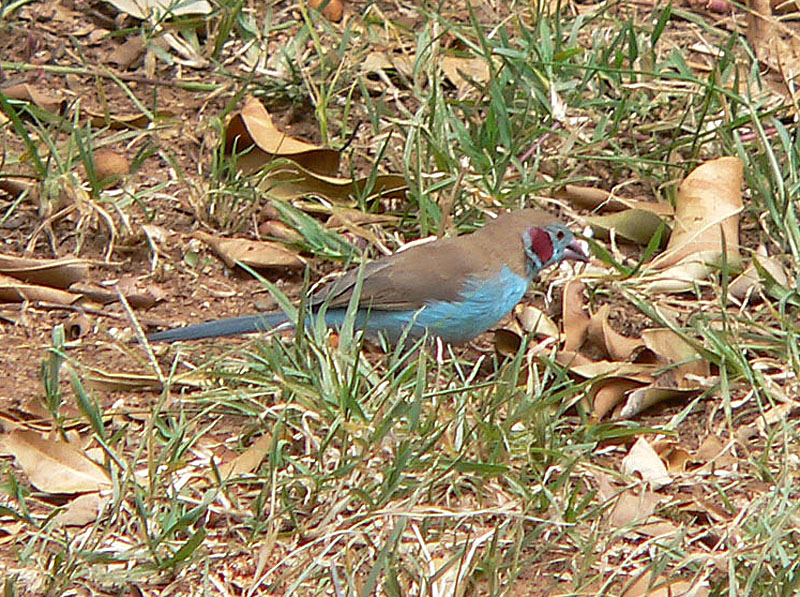Introduction
Every aviculturist remembers her or his first pair of successfully breeding birds – nothing quite matches the experience. However, attempting to breed many popular species is often a time consuming and frustrating experience, and usually demands a good deal of space. Parrots in particular are notoriously choosy about both mate and nest site selection. Finches offer a pleasant entry into the field, and I suggest that you consider getting your start with one of the many colorful, interesting species available. You are more likely to succeed in your early attempts (or, rather, the birds are more likely to succeed!) and a pair can be more easily accommodated in fairly small quarters.
In this article I’ll highlight the basics of finch breeding – future notes will cover fine points concerning individual species.
The Cage
Birds of all kinds are more likely to pair up and breed if provided with a roomy, secure cage and an environment that meets, and even exceeds, their needs. You should, therefore, choose the largest cage possible for your finches – remember, a cage can be fine for maintaining fiches but fail badly as a breeding habitat. In sub-optimal captive conditions, reproduction is the first activity to be abandoned (this applies across the animal kingdom, from invertebrates to mammals). If an outdoor aviary is a possibility, by all means utilize it – your chances at success will be greatly improved.
Light Quality and Photoperiod
Full-spectrum lighting is essential to bird health and functions in encouraging natural behavior, including reproduction. Be sure to maintain your finches under a bulb designed for use with birds (please see my article “Lighting for Your Pet Bird”, May 12, 2008 for further details).
A natural light cycle is also important – this will vary by species but most commonly will fall within the range of 12 hours of day and 12 hours of night. Some finches are stimulated to breed by a change in day length, so research your species carefully and install light timers if necessary.
Sex Determination
An obvious prerequisite to reproduction is 1 bird of each sex. Some finches, i.e. gouldians, zebras and green singers, are quite easy to sex (except for certain color phases) while the secondary sex characteristics of others, i.e. the various whydahs, become evident only during the breeding season. Visual sex-determination is nearly impossible for tri-color nuns, parrot finches and a number of other species. In these cases one must rely upon the birds’ behaviors, such as singing (or what passes for “singing” among some finches!), for clues.
Mate Choice and Pair-Bonding
Always attempt to secure unrelated individuals when pairing birds, and allow them to bond and adjust to their home for 4-6 weeks before adding a nest site. Finches can be choosy when selecting mates – you can improve a male’s “desirability” by providing him with a nutritious diet, and by giving the pair a large, well-provisioned cage located in a quiet location (the female, in theory, will view the male as being in possession of a good territory).
Mutual preening and species-specific courtship displays (research the species that you keep before-hand) are signs that you should introduce the nesting site Mounting can be a dominance display as opposed to a mating attempt, so be sure to watch your birds’ other behaviors as well.
The Nest
Depending upon the species, finches may utilize covered nests (waxbills, zebras, nuns), nest boxes (gouldians), or open nests (canaries, green singing finches). Position the nest in a location that is hidden from view, i.e. behind an artificial plant, for particularly shy species or individuals. Dried grass is an ideal nesting material for most finches – avoid string, cotton and other materials that may bind the legs.
Using Food to Induce Breeding
Many birds, including some finches, are stimulated to breed by seasonal changes that bring an abundance of certain foods. Provision your birds with small mealworms and crickets, as well as extra greens (sprout pot) and fruit. An old zoo trick that I have used with great success is the feeding of wild-caught insects. The sudden appearance of such novel foods really seems to have a strong influence on breeding condition. I highly suggest that you use Zoo Med’s Bug Napper to secure small moths, beetles and other insects (learn to identify toxic species, and avoid brightly-colored insects in general). An adequate supply of calcium (Kay Tee Hi Cal Grit and other products) is particularly important for reproductively active females.
Finches raising chicks should also be supplied with live insects, egg food and, as always, a high quality seed mix.
The Eggs and Chicks
Finches may lay between 2 and 10 eggs, with 4-6 being an average clutch. Incubation time varies by species, but is generally between 9 and 16 days.
Do not be discouraged if your birds fail to incubate their first clutch, or lose the chicks. This is common among young breeders – their performance usually improves over time. Chicks that fall or are tossed from the nest should be returned. Hand rearing of small nestlings is difficult but not impossible.
Information concerning the Australia Zoo’s finch breeding efforts, along with natural history notes on several species, is posted at:
Austaliazoo.com
 Whether they are hand or parent-reared, young Canaries usually need some encouragement to switch from the nestling to adult diet. This change-over period can be quite stressful, but there are a number of steps you can take to ease the transition.
Whether they are hand or parent-reared, young Canaries usually need some encouragement to switch from the nestling to adult diet. This change-over period can be quite stressful, but there are a number of steps you can take to ease the transition. That Bird Blog – Bird Care and History for Pet Birds
That Bird Blog – Bird Care and History for Pet Birds



 Upon fledging, the chicks should be fed on a 6AM – 8PM schedule until they begin pecking at food on their own. Most begin trying solid food on the fifth day after fledging, but this varies widely…close observation is very important at this point.
Upon fledging, the chicks should be fed on a 6AM – 8PM schedule until they begin pecking at food on their own. Most begin trying solid food on the fifth day after fledging, but this varies widely…close observation is very important at this point. Waxbills and their relatives are often the first finches aviculturists obtain after having gained experience with the hardier zebra or society finches. The black-headed munia and several others are well suited to this role – slightly more sensitive than Zebra Finches, yet robust enough to fare well when given proper care.
Waxbills and their relatives are often the first finches aviculturists obtain after having gained experience with the hardier zebra or society finches. The black-headed munia and several others are well suited to this role – slightly more sensitive than Zebra Finches, yet robust enough to fare well when given proper care. Waxbills, nuns and munias are best housed in large
Waxbills, nuns and munias are best housed in large